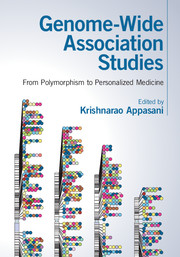Book contents
- Frontmatter
- Dedication
- Contents
- List of contributors
- Forewords
- Preface
- List of abbreviations
- Part I Genome-wide association studies
- Part II Genome-wide studies in disease biology
- 5 Genome-wide association studies of body mass index
- 6 Identification of myocardial infarction-susceptible genes and their functional analyses
- 7 Admixture mapping for disease gene discovery
- 8 Genome-wide association analysis in schizophrenia
- 9 Epigenome-wide association studies in neurodevelopmental disorders
- Part III Single nucleotide polymorphisms, copy number variants, haplotypes and eQTLs
- Part IV Next-generation sequencing technology and pharmaco-genomics
- Part V Population genetics and personalized medicine
- Index
- Plate section
- References
6 - Identification of myocardial infarction-susceptible genes and their functional analyses
from Part II - Genome-wide studies in disease biology
Published online by Cambridge University Press: 18 December 2015
- Frontmatter
- Dedication
- Contents
- List of contributors
- Forewords
- Preface
- List of abbreviations
- Part I Genome-wide association studies
- Part II Genome-wide studies in disease biology
- 5 Genome-wide association studies of body mass index
- 6 Identification of myocardial infarction-susceptible genes and their functional analyses
- 7 Admixture mapping for disease gene discovery
- 8 Genome-wide association analysis in schizophrenia
- 9 Epigenome-wide association studies in neurodevelopmental disorders
- Part III Single nucleotide polymorphisms, copy number variants, haplotypes and eQTLs
- Part IV Next-generation sequencing technology and pharmaco-genomics
- Part V Population genetics and personalized medicine
- Index
- Plate section
- References
Summary
Introduction
Coronary artery disease (CADs), including myocardial infarction (MI), have been the major cause of mortality and morbidity among late-onset diseases in many industrialized countries with a Western lifestyle (Braunwald, 1997; Breslow, 1997). MI often occurs without any preceding clinical signs and is followed by severe complications, especially ventricular fibrillation and cardiac rupture, which might result in sudden death. Although recent advances in treatment and diagnosis have greatly improved the quality of life for patients after MI, its morbidity is still high. MI is a disease of the vessel that feeds the cardiac muscle, called the coronary artery. Abrupt occlusion of the coronary artery results in irreversible damage to cardiac muscle. Plaque rupture with thrombosis is a well-established critical factor in the pathogenesis of MI (Falk et al., 1995; Libby, 1995). Although the detailed mechanisms of plaque rupture are unknown, inflammation is thought to play an important role in its pathogenesis (Ross, 1999). Inflammatory mediators like cytokines are involved in atheroma formation; rapid evolution of the atheromatous injury, leading to rupture of the plaque; and intraluminal thrombosis (Ross, 1999). Epidemiologic studies reveal that coronary risk factors include type 2 diabetes mellitus, hypercholesterolemia, hypertension, and obesity. Some studies report a genetic factor; one reported that first-degree relatives of patients who have had an acute MI before age 55 have a 2–7-times higher risk of MI (Lusis et al., 2004). A twin study indicated an eightfold increase in risk of death from MI when a first twin dies of MI before age 55 (Marenberg et al., 1994). Common genetic variants are believed to contribute to genetic risk of disease (Lander, 1996; Risch and Merikangas, 1996; Collins et al., 1997). In this context, we started genome-wide association studies (GWAS) for MI using nearly 90,000 gene-based SNPs (http://snp.ims.u-tokyo.ac.jp/; Haga et al., 2002) by high-throughput multiplex polymerase chain reaction (PCR) invader assay system (Ohnishi et al., 2001), and identified several genes associated with the risk of MI including LTA (Ozaki et al., 2002; Ishii et al., 2006; Ebana et al., 2007; Aoki et al., 2011). Although the detailed roles of these susceptible genes in MI pathogenesis are under investigation, these findings showed the potent power of GWAS, which is hypothesis-free, to identify unexpected anchors to further understand the disease.
- Type
- Chapter
- Information
- Genome-Wide Association StudiesFrom Polymorphism to Personalized Medicine, pp. 79 - 88Publisher: Cambridge University PressPrint publication year: 2016



